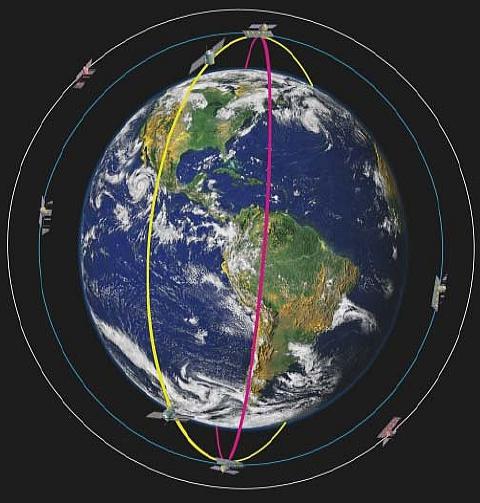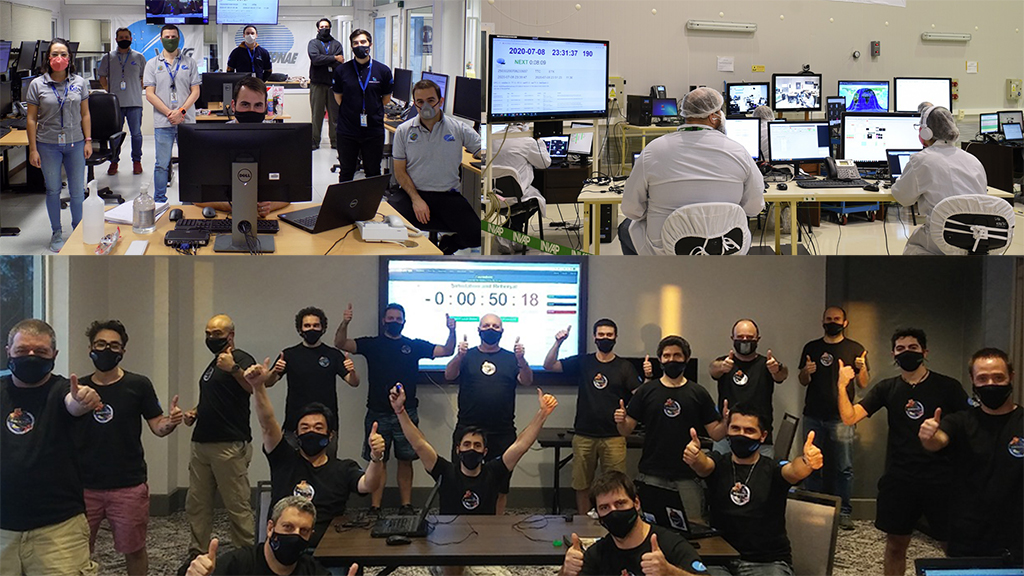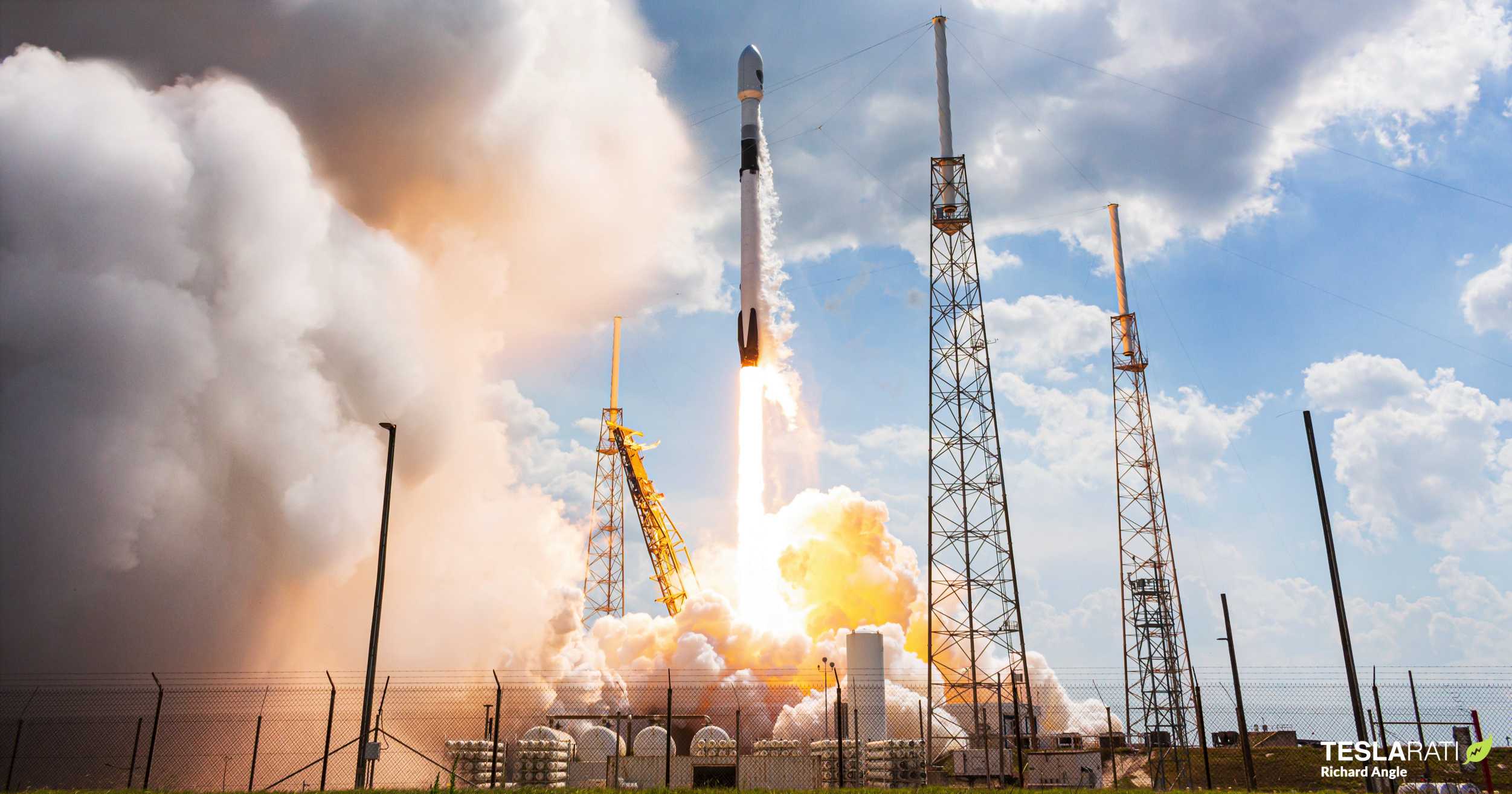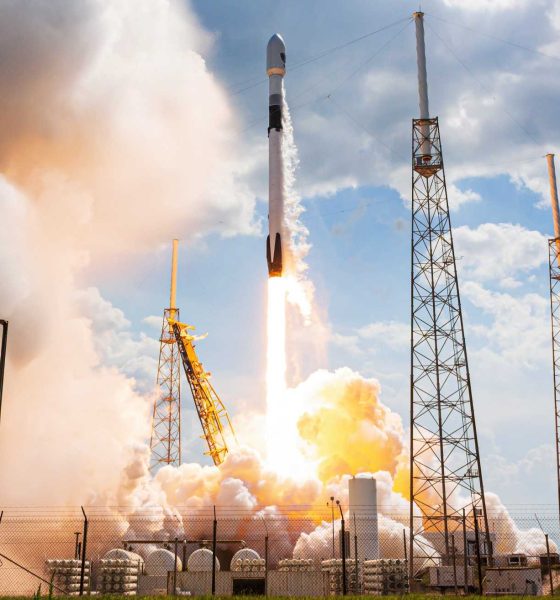SpaceX is set to make history by returning southern trajectory polar corridor launches to Florida’s Space Coast with the launch of the Argentine SAOCOM-1B radar observation satellite later this month. Tentatively set to get off the ground no earlier than Saturday, July 25 the SAOCOM-1B mission has suffered delays ranging from hardware processing and integration to international launch team travel restrictions as a result of the global coronavirus pandemic.
In late February 2020, the SAOCOM-1B satellite departed Argentina aboard a Russian Antonov AN 124 cargo aircraft and arrived at the Shuttle Landing Facility in Cape Canaveral, Florida. It was expected that launch and processing teams from Argentina’s National Commission for Space Activities (CONAE) would quickly follow to meet a March launch timeline. However, international travel restrictions imposed by the Argentine government in early March meant that SpaceX would have to wait an indeterminant amount of time to attempt the historic polar launch from Florida. As a result, the satellite was put into storage in one of SpaceX’s satellite processing facilities in Florida to await the arrival of its launch team.

A change in launch plans
The SAOCOM-1B satellite was initially thought to launch from Vandenberg Air Force Base (VAFB) in California just as its twin predecessor, the SAOCOM-1A satellite did in October of 2018. At the time VAFB was the only US-based launch site used for polar orbit launch corridor services. However, Cape Canaveral Air Force Station had previously announced the option to re-open a southern polar orbit launch corridor from Florida in 2017, a launch trajectory that hadn’t been used in over half a century.
The option of polar trajectory launches from Florida increased SpaceX’s capacity to streamline its launch manifest to the company’s dual launchpad locations on Florida’s East Coast. In 2019, as reported by Michael Baylor of NASASpaceflight.com, SpaceX formally requested to move the launch of the SAOCOM-1B satellite from VAFB to Florida utilizing a southern, coast-hugging dog-leg trajectory over Cuba to a final polar orbital inclination.
For those asking for a visual of what a southward, doglegged polar launch trajectory out of Cape Canaveral will look like, here you go. https://t.co/FTTW8mbq0J pic.twitter.com/59YXoERkQl— Chris G (@ChrisG_SpX) October 9, 2019
The SAOCOM-1B satellite will join its L-Band, synthetic-aperture radar (SAR) SAOCOM-1A sister satellite in a sun-synchronous orbit (SSO) – essentially an orbit over the poles of the planet that allows the solar arrays of the satellite to be in sunlight at any given time. The satellites operate in SSO and use L-Band and synthetic-aperture radar to create two-dimensional, all-weather Earth observation imagery to assist in global disaster-monitoring efforts. The sister satellites will also work in conjunction with a constellation of four Italian satellites already in orbit operated by COSMO-SkyMed.

Return to operational status
Following the easement of certain international travel restrictions in mid-July, a slim crew of 18 team members from CONAE and SAOCOM-1B satellite manufacturer INVstigacion APlicada (INVAP) was permitted to travel to Florida. The team members tested negatively for the COVID-19 virus prior to commercially traveling to Florida from Argentina, as well as, after their arrival at Miami International Airport. The team observed a two-week period of quarantine prior to traveling to SpaceX facilities at Cape Canaveral Air Force Station to begin pre-operational tasks.
On Monday, July 13 the team was able to get to work on launch campaign tasks with the satellite that had endured months of storage. The team ensured the health of the satellite and completed a full launch day simulation managed remotely from locations in Florida and Argentina. Following a successful run through and check of the satellite’s operational status, the launch campaign has just a few remaining steps before rocketing SpaceX into the history books once again.

SpaceX and CONAE teams will work together to safely encapsulate the satellite inside of a protective Falcon 9 payload fairing and mate the payload with the first stage Falcon 9 booster. Furthermore, the teams will complete a joint integration test of the payload and launch vehicle before finally transporting it to the launch pad.
The SpaceX launch manifest has recently undergone some schedule shuffling potentially leaving the SAOCOM-1B mission to be third in line behind the launch of the South Korean ANASIS-II military communications satellite and the delayed Starlink-9 mission. However, earlier in the week, the Starlink-9 booster was lowered from launch position at LC-39A and returned to the horizontal integration facility following a scrubbed launch attempt with SpaceX citing that more time was necessary to perform final check-outs. This most likely suggests that SpaceX plans to push the SAOCOM-1B mission ahead of Starlink-9 in the launch manifest.
According to CONAE, the SAOCOM-1B mission launch window extends from Saturday, July 25 to Thursday, July 30 with a targeted liftoff at approximately 7:19 p.m. EDT (2319 GMT) from SLC-40.
Check out Teslarati’s newsletters for prompt updates, on-the-ground perspectives, and unique glimpses of SpaceX’s rocket launch and recovery processes.

News
Tesla aims to combat common Full Self-Driving problem with new patent
Tesla writes in the patent that its autonomous and semi-autonomous vehicles are heavily reliant on camera systems to navigate and interact with their environment.

Tesla is aiming to combat a common Full Self-Driving problem with a new patent.
One issue with Tesla’s vision-based approach is that sunlight glare can become a troublesome element of everyday travel. Full Self-Driving is certainly an amazing technology, but there are still things Tesla is aiming to figure out with its development.
Unfortunately, it is extremely difficult to get around this issue, and even humans need ways to combat it when they’re driving, as we commonly use sunglasses or sun visors to give us better visibility.
Cameras obviously do not have these ways to fight sunglare, but a new patent Tesla recently had published aims to fight this through a “glare shield.”
Tesla writes in the patent that its autonomous and semi-autonomous vehicles are heavily reliant on camera systems to navigate and interact with their environment.

The ability to see surroundings is crucial for accurate performance, and glare is one element of interference that has yet to be confronted.
Tesla described the patent, which will utilize “a textured surface composed of an array of micro-cones, or cone-shaped formations, which serve to scatter incident light in various directions, thereby reducing glare and improving camera vision.”

The patent was first spotted by Not a Tesla App.
The design of the micro-cones is the first element of the puzzle to fight the excess glare. The patent says they are “optimized in size, angle, and orientation to minimize Total Hemispherical Reflectance (THR) and reflection penalty, enhancing the camera’s ability to accurately interpret visual data.”
Additionally, there is an electromechanical system for dynamic orientation adjustment, which will allow the micro-cones to move based on the angle of external light sources.
This is not the only thing Tesla is mulling to resolve issues with sunlight glare, as it has also worked on two other ways to combat the problem. One thing the company has discussed is a direct photon count.
CEO Elon Musk said during the Q2 Earnings Call:
“We use an approach which is direct photon count. When you see a processed image, so the image that goes from the sort of photon counter — the silicon photon counter — that then goes through a digital signal processor or image signal processor, that’s normally what happens. And then the image that you see looks all washed out, because if you point the camera at the sun, the post-processing of the photon counting washes things out.”
Future Hardware iterations, like Hardware 5 and Hardware 6, could also integrate better solutions for the sunglare issue, such as neutral density filters or heated lenses, aiming to solve glare more effectively.
Elon Musk
Delaware Supreme Court reinstates Elon Musk’s 2018 Tesla CEO pay package
The unanimous decision criticized the prior total rescission as “improper and inequitable,” arguing that it left Musk uncompensated for six years of transformative leadership at Tesla.

The Delaware Supreme Court has overturned a lower court ruling, reinstating Elon Musk’s 2018 compensation package originally valued at $56 billion but now worth approximately $139 billion due to Tesla’s soaring stock price.
The unanimous decision criticized the prior total rescission as “improper and inequitable,” arguing that it left Musk uncompensated for six years of transformative leadership at Tesla. Musk quickly celebrated the outcome on X, stating that he felt “vindicated.” He also shared his gratitude to TSLA shareholders.
Delaware Supreme Court makes a decision
In a 49-page ruling Friday, the Delaware Supreme Court reversed Chancellor Kathaleen McCormick’s 2024 decision that voided the 2018 package over alleged board conflicts and inadequate shareholder disclosures. The high court acknowledged varying views on liability but agreed rescission was excessive, stating it “leaves Musk uncompensated for his time and efforts over a period of six years.”
The 2018 plan granted Musk options on about 304 million shares upon hitting aggressive milestones, all of which were achieved ahead of time. Shareholders overwhelmingly approved it initially in 2018 and ratified it once again in 2024 after the Delaware lower court struck it down. The case against Musk’s 2018 pay package was filed by plaintiff Richard Tornetta, who held just nine shares when the compensation plan was approved.
A hard-fought victory
As noted in a Reuters report, Tesla’s win avoids a potential $26 billion earnings hit from replacing the award at current prices. Tesla, now Texas-incorporated, had hedged with interim plans, including a November 2025 shareholder-approved package potentially worth $878 billion tied to Robotaxi and Optimus goals and other extremely aggressive operational milestones.
The saga surrounding Elon Musk’s 2018 pay package ultimately damaged Delaware’s corporate appeal, prompting a number of high-profile firms, such as Dropbox, Roblox, Trade Desk, and Coinbase, to follow Tesla’s exodus out of the state. What added more fuel to the issue was the fact that Tornetta’s legal team, following the lower court’s 2024 decision, demanded a fee request of more than $5.1 billion worth of TSLA stock, which was equal to an hourly rate of over $200,000.
Delaware Supreme Court Elon Musk 2018 Pay Package by Simon Alvarez
News
Tesla Cybercab tests are going on overdrive with production-ready units
Tesla is ramping its real-world tests of the Cybercab, with multiple sightings of the vehicle being reported across social media this week.

Tesla is ramping its real-world tests of the Cybercab, with multiple sightings of the autonomous two-seater being reported across social media this week. Based on videos of the vehicle that have been shared online, it appears that Cybercab tests are underway across multiple states.
Recent Cybercab sightings
Reports of Cybercab tests have ramped this week, with a vehicle that looked like a production-ready prototype being spotted at Apple’s Visitor Center in California. The vehicle in this sighting was interesting as it was equipped with a steering wheel. The vehicle also featured some changes to the design of its brake lights.
The Cybercab was also filmed testing at the Fremont factory’s test track, which also seemed to involve a vehicle that looked production-ready. This also seemed to be the case for a Cybercab that was spotted in Austin, Texas, which happened to be undergoing real-world tests. Overall, these sightings suggest that Cybercab testing is fully underway, and the vehicle is really moving towards production.
Production design all but finalized?
Recently, a near-production-ready Cybercab was showcased at Tesla’s Santana Row showroom in San Jose. The vehicle was equipped with frameless windows, dual windshield wipers, powered butterfly door struts, an extended front splitter, an updated lightbar, new wheel covers, and a license plate bracket. Interior updates include redesigned dash/door panels, refined seats with center cupholders, updated carpet, and what appeared to be improved legroom.
There seems to be a pretty good chance that the Cybercab’s design has been all but finalized, at least considering Elon Musk’s comments at the 2025 Annual Shareholder Meeting. During the event, Musk confirmed that the vehicle will enter production around April 2026, and its production targets will be quite ambitious.











